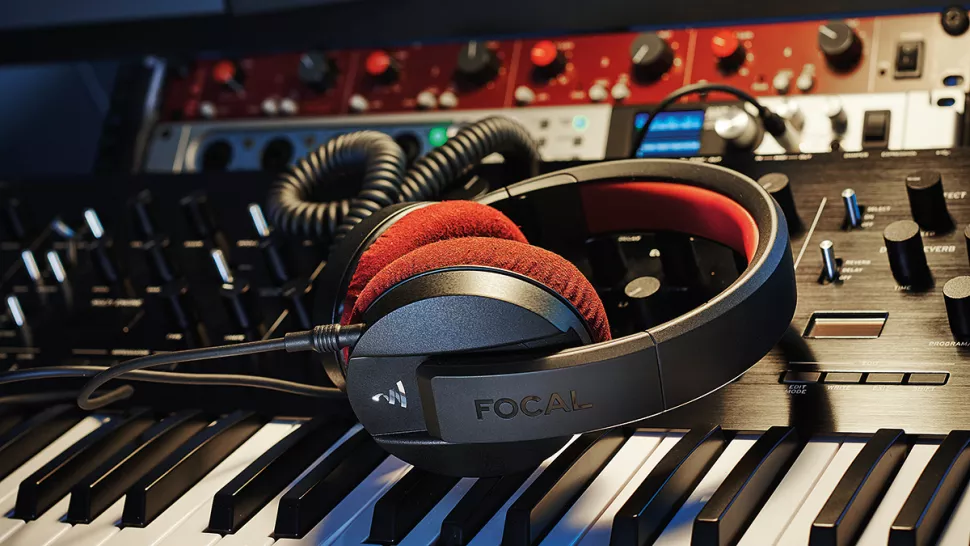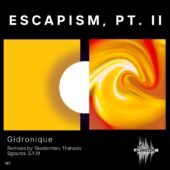Best studio headphones

When monitoring your latest mixes or recording in the studio, a pair of the best studio headphones, in our opinion, is a must have. Any music producer worth their salt will tell you that they monitor using as many different systems as they can lay their hands on: a pair of studio monitors, a Bluetooth speaker, even a car stereo. And, of course, the best quality studio headphones their budget will stretch to.
A great pair of studio headphones is probably a producer’s most used item in their studio. They’re an essential tool for assessing the stereo image, low-end and fine detail within a mix. Just like studio monitors, it’s important to choose the right pair of studio headphones, but it is a very personal choice.
In the studio, the best monitor headphones for you will be the ones that you can mix on and craft the most epic sounding result possible. Perhaps you’re looking for a pair of studio headphones solely for mixing, or something that you can employ for everyday music-listening duties too. If you’re looking for a pair of workhorse cans sturdy enough to cope with life on the go, studio headphones can do that too – as they’re usually built to a higher standard than most general-listening cans.
To help with your choice, this guide to the best studio headphones includes our top picks. We’ve reviewed every model and have highlighted the strengths, weaknesses and suitability for different musical disciplines below.
Our price comparison software has also found the best prices on the web right now, so you can be sure you’re grabbing a bargain once you’ve decided on the pair for you. If your budget is smaller, then no worries – take a look at our guide to the best budget studio headphones.
We’ve included some buying advice at the bottom of this guide, so if you’re here to learn more about the best studio headphones, hit the ‘buying advice’ button above. If you’d rather get straight to the products, then keep scrolling.
BEST STUDIO HEADPHONES: OUR TOP PICKS
If your budget is on the smaller side, then our pick for the best studio headphones has to be the Sennheiser HD-206. These are pocket-friendly headphones that have been around for ages, but the overall performance that they offer is anything but bargain bucket. These headphones are great for use in the studio, plus they’re supremely light, comfortable and durable for those extra long days of recording and mixing.
Our mid-range pick has to be a pair of the Sony MDR-7506s. They’ve featured in recording studios, radio stations and DJ booths for the last 35 years, and continue to be regarded as one of the very best. For under £100, it’ll be tough to find cans as good as these.
As you move further up the price scale, the decisions get a little more difficult. We’d gladly recommend the Focal Listen Professional as our pick for those with a little more cash to splash, though. They’re competitively priced and have an excellent pedigree (Focal is among the most highly-regarded monitor manufacturers out there), and we doubt you’ll find a better pair of headphones for similar money.
BEST STUDIO HEADPHONES: PRODUCT GUIDE

The Focal Listen Professionals are exactly what they say on the tin; ideal for both listening and pro duties. This puts them firmly top of the class in the all-rounder category. Overall, the fit is snug, but not too tight that long periods in the mixing saddle are unbearable.
In fact far from it, the longest period of time we had them on for was around three hours, with the main issues just being back pain and the lack of blinking. While many engineers and audio specialists might prefer open-backed designs for their lack of fatigue, the closed Listen Pros perform admirably in this regard.
We found the response of these cans to be perfectly balanced, with remarkably neutral, punchy bass with plenty of extension, full, clear mids and sparkling, smooth highs. Complete with a beautiful hard-shell case, we don’t think there’s a better all-round studio headphone out there at this price.

If you’re in the market for a cheap pair of headphones for everyday studio use, you need to check out the Sennheiser HD-206. Bearing the well-respected Sennheiser name on the headband, the extremely tough and durable HD-206’s are comfortable to wear for extended periods.
Remarkably accurate for the money, the HD-206’s measure up more than favourably to much pricier peers. The bass response in particular is rich and crisp, with plenty of detail also to be found in the mids and highs – making these potentially some of the best guitar amp headphones.
The hypoallergenic ear pads are more than adequate for blocking out extraneous noise whether in the studio or out on the move, and at this price, you need never fear recklessly throwing these in your laptop bag. Grab a pair before Sennheiser realise how good they are and raise the price.

The Sony MDR series has been around for years and has a solid studio pedigree, borne out by decades of daily use in the recording and broadcast sectors worldwide. The current incarnation, the MDR-7506 is a brilliant combination of comfort, practicality and value.
Extremely comfortable to wear for extended periods, these are designed to expose what’s wrong with a recording rather than what’s right. On a par with other cans costing twice as much, the sound is punchy and clear throughout the spectrum (with a moderate boost in the upper mids), while managing not to be overly-flattering.
So all in all the fact that these workhorse cans are available for well under a hundred quid is not to be sniffed at.

Another long-standing studio favourite, HD-25’s are acclaimed by pros for their ability to handle high sound pressure levels and deliver excellent sound reproduction. A stalwart of the booth thanks to their split headband, rotatable earpieces and reputation for durability, the HD-25 delivers punchy and accurate sound in a lightweight yet robust package.
Classified as an on-ear design, because the pads are circular and rest on the outside of the ear rather than enclosing it fully, the HD-25 is currently available in three flavours (Light, Standard and Plus) at three price points, for general studio/DJ duties you really can’t go wrong with a pair of Sennheiser HD-25’s.

The reissued M50 (‘x’ = detachable cable) is a popular model across the audio world, competing directly with Beyerdynamic and AKG. They are comfortable, fold and bend in all the right places, and are relatively light (285g).
The sound quality is good overall, though they do shy away from a detailed, airy HF region. The mids are clear and forward, while the bottom-end extends down without any peaky resonances. As with all the low impedance designs here (these are 38 ohm), they are easily driven beyond our comfort threshold.

Open-back designs like the ATH-R70x tend to be favoured for long mix sessions as they’re generally lighter and less fatiguing than closed-back cans, which is good news as this model has been developed especially as a reference headphone for mixing.
At this price and above we’ve used models with more apparent ‘air’, but we don’t consider this a deficiency – if anything, it means you’re less likely to end up with a dull mix. Down the other end the response is no less smooth with all the extension you need without the slightest hint of boom or false fatness.
Moving up, the low mids continue unwrinkled, free from cheap scooping back (a voicing often employed to mask uneven response) so you can really hear what’s going on, for better or for worse. It’s all about the mids and low mids for us, and with the R70x all the juice comes through without complications; everything appears clearly delineated and unmuddled, unless the source is otherwise.
It’s a high-impedance model, so you’ll need a suitable headphone amp to connect them to for best results.

Beyerdynamic is an audio heavyweight, responsible for the ubiquitous DT 100 tracking cans that were everywhere in the 1980’s and 90’s and are still available today. Their current range is huge, but designed specifically for mixing, the DT 1770s are exceedingly well balanced across the audible spectrum.
The mid range is free from audible phase shift, allowing the clarity essential for professional use. The sound stage projected into your head is as pleasurable as it is revealing. They provide a highly detailed view into your audio, from left to right, front to back, and even into the corners.
Being a high-impedance design, you’ll need to drive them hard, but from discrete reverb tails tucked behind a busy mid range, to tiny distortions and clips, they reproduce whatever your signal chain is capable of supplying. Audio restoration, mixing and tracking all greatly benefit from the quality the DT 1770s offer.

Relative newcomers to the pro headphone market, Austrian Audio fielded their latest studio-centric, open-back design in July of 2021 and have already scored a direct hit with critics and customers alike. Excellent, balanced sound that remains neutral yet highly detailed, coupled with solid build quality, all leads to an enjoyable listening experience whatever the setting.
Foldable construction for added portability, twin detachable cables of different 3-metre and 1.2-metre lengths to suit a variety of tasks and soft, slow-retention memory foam earpads for extended comfort all add to the appeal.
If you’re in the market for a premium pair of headphones that excels for mixing and critical listening, the Hi-X65’s tick a lot of boxes.

With a pro audio pedigree stretching back decades, Shure is a name you should be able to trust when choosing a set of headphones for your studio. The premium model SRH1540’s do not disappoint, delivering excellent acoustic performance, comfort and durability to professionals and audiophiles alike.
Offering an expansive soundstage and immaculate transient detail across the board, with clear, extended highs and warm bass in a lightweight alloy and carbon fibre architecture, the 1540’s are topped off with swish Alcantara leather earpads for supreme comfort and sound isolation.
Though far from the cheapest option on the list, the performance delivered by the 1540’s undoubtedly proves more than sufficient reward for the investment.

Beyerdynamic headphones have been renowned by professionals and amateurs alike, being the to-go studio headphones for producers seeking extremely high build quality and durability.
Like the DT-1770 models – already featured in this guide – the DT-770s offer a fantastic flat frequency base, allowing you to hear exactly how your mix sounds in intense detail. In addition, the comfortable soft padded headband means you can spend hours labouring over your mix without fatigue, while the rugged design means they are sure to last.
Coming in at a far more wallet-friendly price point – compared to the DT-1770 – these fantastic headphones offer fantastic value for money and are a great first step into the world of studio headphones.

Headphones can be a good way to judge bass when the available monitors don’t reach down too far, and in this regard the HRM-7s don’t disappoint. There’s no hyping, just a clear picture of what’s going on down low. The low-mid and mid range are crucial for the real meat in any mix, and it can be easy to make a mess here without decent monitoring.
The HRM-7s present the detail in this range accurately; no carving out or pushing forward which are often the side effects of bass-hyped or bass light designs (respectively). The airy top, ie 15kHz and up, is all present and correct so you can control the ‘twinkle’ without second-guessing. The upper mid/early high range (5kHz) is a little overrepresented for our taste, which makes us mix this region too far back.

Nura’s Nuraphone system is unique in that it automatically generates a personalised user profile, then tailors its response to suit your hearing, creating a bespoke listening experience. There’s almost no point in us telling you how good these headphones sound, as they’re going to sound great to you, no matter what.
The profiling is voiced in a such a way to sound very pleasing, with a crisp and detailed top-end, slightly scooped mids and haptic drivers that deliver more than enough low-end to offer plenty of depth and immersion. Of course how this is achieved differs with each user, but they perform admirably when stacked up against other headphones at a similar price point, so be prepared to find yourself going back over old mixes and making some tweaks.
Even though the Nuraphones fit firmly into the ‘listening’ category of headphones, the technology is fascinating and they do prove useful as an alternative monitoring source in the studio – perfect for those hasty club mixes if you’re missing a sub-woofer in your speaker setup.

The MP-240 uses a dynamic driver for bass and a balanced armature for the mids and highs (Mackie call it a dual hybrid design), and although this model isn’t substantially more expensive than the MP-220, we feel it’s streets ahead sonically. First up, the mid range is more defined yet overall feels less prominent, which should be less fatiguing.
However, it’s the top end where these really win, with clear yet smooth high frequencies delivering excellent articulation. Indeed, switching back over to the MP-220 only goes to hammer home how much better the MP-240 sounds.

It’s hard to imagine even the best in ear monitors delivering a sound you can rely on for production duties, but be it tracking, sound design or mixing, the E70s impress from top to bottom. They don’t quite rival an equally-priced set of headphones, especially in the bass, a region in which physics throws up some serious constraints.
Subs are audible and there’s no low mid scooping to mask poor phase response; the bass is just less punchy than you’d get with the average studio headphones.
The mids are clear and free from fatiguing peaks, so the meat of a mix can be tackled with confidence, and even if the high frequency range is slightly soft, subtle adjustments come through clearly enough that you’ll be happy using EQ in this region.
Source: https://djmag.com/


















